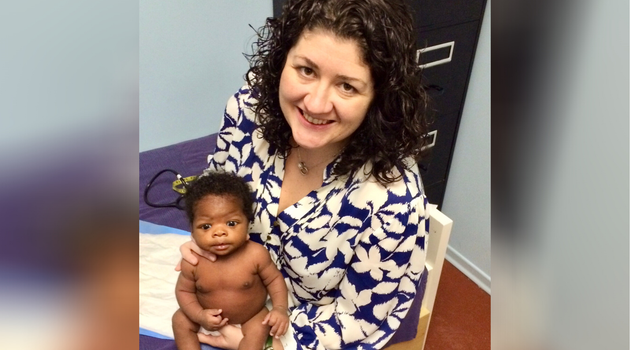Ontario Midwives Delivering Babies During Pandemic Aren’t ‘Front Line’: Ministry Of Health
They’re working in hospitals and homes to support mothers who’ve tested positive for COVID-19.By Samantha Beattie

SUPPLIEDToronto midwife Christie Lockhart wears personal protective equipment during a 24-hour hospital shift where she attended six births during the COVID-19 crisis.
TORONTO — For midwife Christie Lockhart, there’s no option to stay home.
Pandemic or not, births will go on, and so will she.
Wearing a mask, gown and a pair of gloves, Lockhart cares for mothers giving birth at home or in the hospital. For those who’ve tested positive for COVID-19, Lockhart teaches them how to safely care for their newborn — stay six feet away as much as possible and wear a mask while breastfeeding.
She picks up extra 24-hour shifts to fill in for her colleagues cannot work, attending half a dozen births. Some of the newborns are tested for the novel coronavirus.
As she heads out the door each day her wife no longer says “have fun,” but rather “stay safe.”
“I can’t tell you how hard it’s been to work through COVID-19,” Lockhart told HuffPost Canada. “And then there’s the very real risk that we all feel when we work in the hospital and the community.”
Despite the heightened risk of contracting COVID-19, midwives are one of the few health-care workers in Ontario not eligible for the provincial government’s “pandemic pay” of $4 extra an hour and $250 a month until mid-August.

SUPPLIEDToronto midwife Christie Lockhart and a client's baby before the pandemic.
“Temporary pandemic pay is aimed at front-line staff who are experiencing severe challenges and are at heightened risk during the COVID-19 outbreak,” said Ministry of Health spokesperson Hayley Chazan in an email when asked why midwives were not included in the pay bump.
More than 30 different types of workers qualify, including nurses, personal support workers, social workers, custodians and correctional officers across long-term care homes, hospitals, shelters, and correctional facilities.
Paramedics, public health nurses, hospital mental health and addiction workers and respiratory therapists were added to the list, “to recognize and thank these front-line workers for putting their health and safety at risk to help our most vulnerable,” Chazan said.
Like midwives, dieticians, physiotherapists, radiation therapists, lab employees and occupational therapists who work in hospitals are also not eligible, despite assisting COVID-19 patients.
Lockhart sees dozens of clients at her Toronto clinic, including low-income women who are particularly vulnerable to contracting COVID-19 because they work multiple jobs, or live in shelters or with numerous people, and cannot truly self-isolate.
“We’re asking for recognition that we’re front-line essential workers,” said Lockhart.
Midwives are responsible for procuring their own personal protective equipment. Clinics like Lockhart’s now pay double the original price for hand sanitizer, and face a dwindling supply of surgical masks. They rely on donations of hand-sewn reusable gowns and 3D-printed face shields to protect them during births and visits.
I was part of the team who cared for the first #COVID__19 positive pregnant pt @MGHBirth but our minister of health @celliottability says #midwives aren't frontline #TellMeImNotEssential@fordnation needs to include midwives in #pandemicpay@ontariomidwivespic.twitter.com/4ZzzqL3i6F
— Jenna Bly (@jennarosaa) May 2, 2020
@celliottability@fordnation@ontariomidwives
In one 24 hour shift, I did surgical assist, I cared for a client who screened positive for covid and I completed two neonatal resuscitations. Oh ya, and I attended three births.#tellmeimnotessential#midwivesOnTheFrontlinepic.twitter.com/8jN3dYIm00
— Nabal Kanaan (@KanaanNabal) May 2, 2020
The Association of Ontario Midwives met with the province last week, and walked away unsuccessful and “deeply concerned,” it said in a statement sent to its 1,000 members.
“This decision is an indication that decision-makers fail to understand the work of midwives or the risks they take on without appropriate PPE,” the association said. The pandemic pay has been dolled out “unevenly, irrationally and inequitably” across the health-care sector.
In 2018, the Ontario Human Rights Tribunal ruled that midwives have faced a long-standing pay gap rooted in gender discrimination. Earlier this year, the tribunal ordered the province to increase their pay by 20 per cent, retroactive to 2011, and award those eligible with $7,500 for injury to dignity.
The province, which is appealing the tribunal decision, was supposed to begin providing midwives with compensation this month.
“This decision is an indication that decision-makers fail to understand the work of midwives or the risks they take on without appropriate PPE,” the association said. The pandemic pay has been dolled out “unevenly, irrationally and inequitably” across the health-care sector.
In 2018, the Ontario Human Rights Tribunal ruled that midwives have faced a long-standing pay gap rooted in gender discrimination. Earlier this year, the tribunal ordered the province to increase their pay by 20 per cent, retroactive to 2011, and award those eligible with $7,500 for injury to dignity.
The province, which is appealing the tribunal decision, was supposed to begin providing midwives with compensation this month.

















